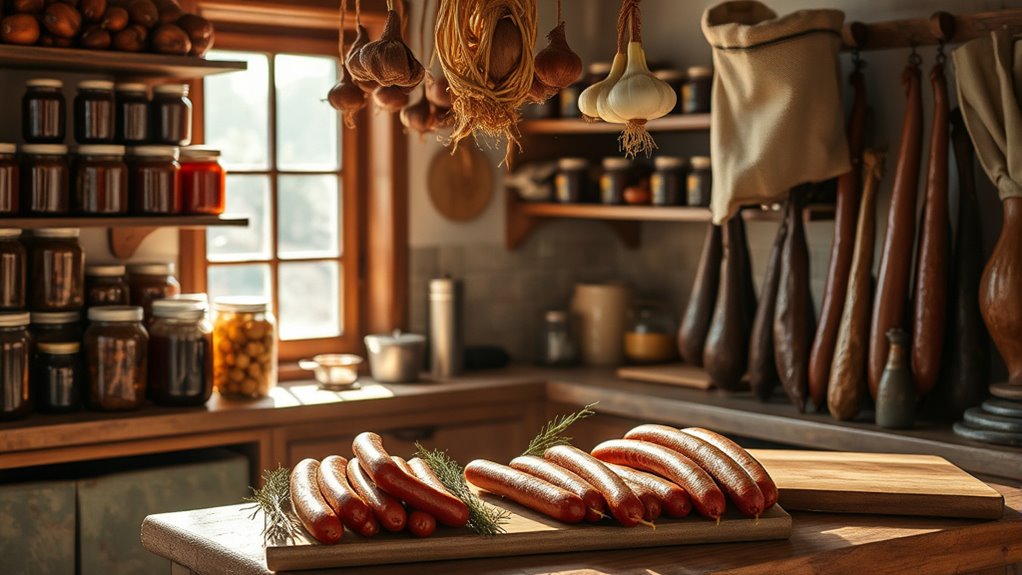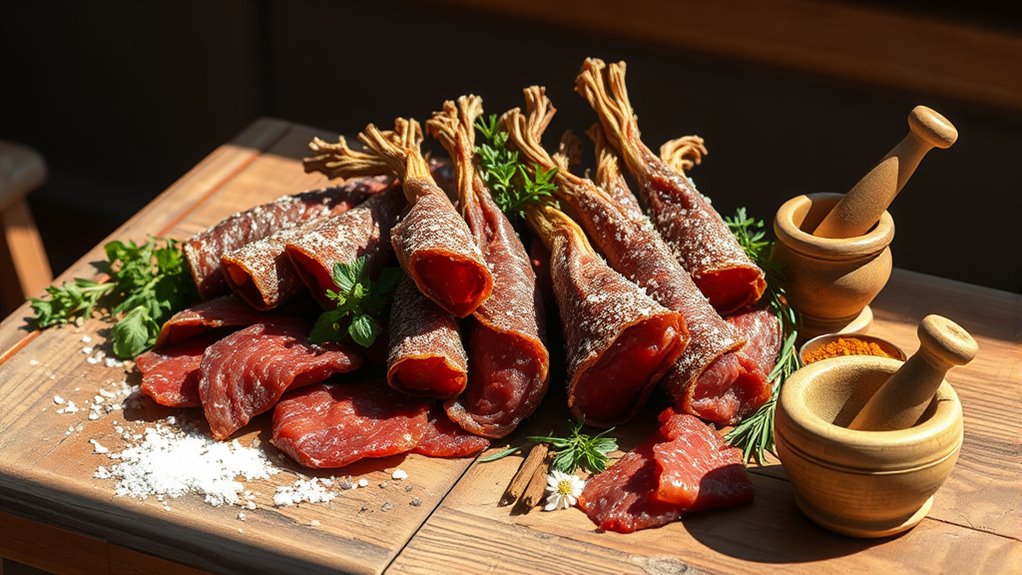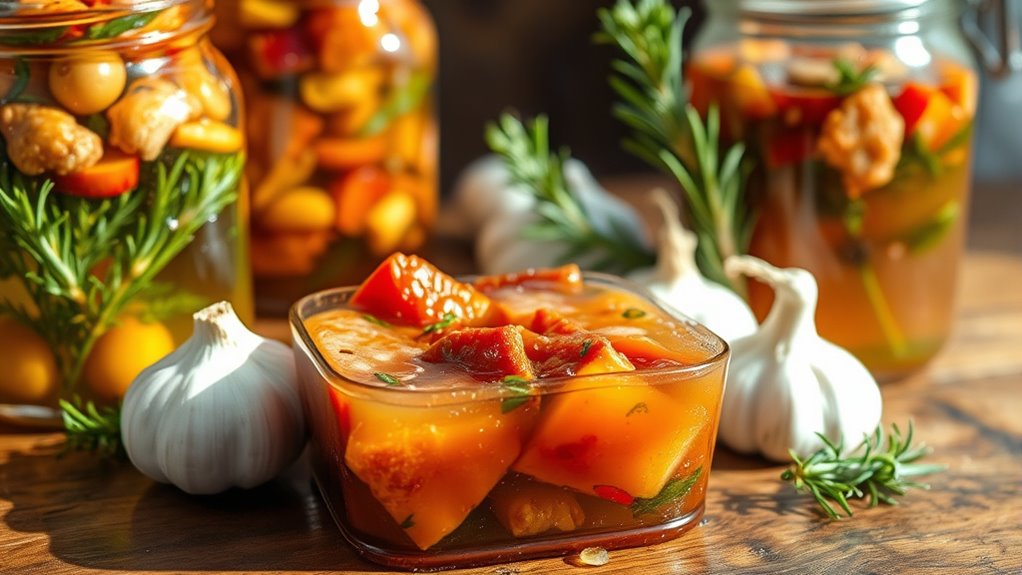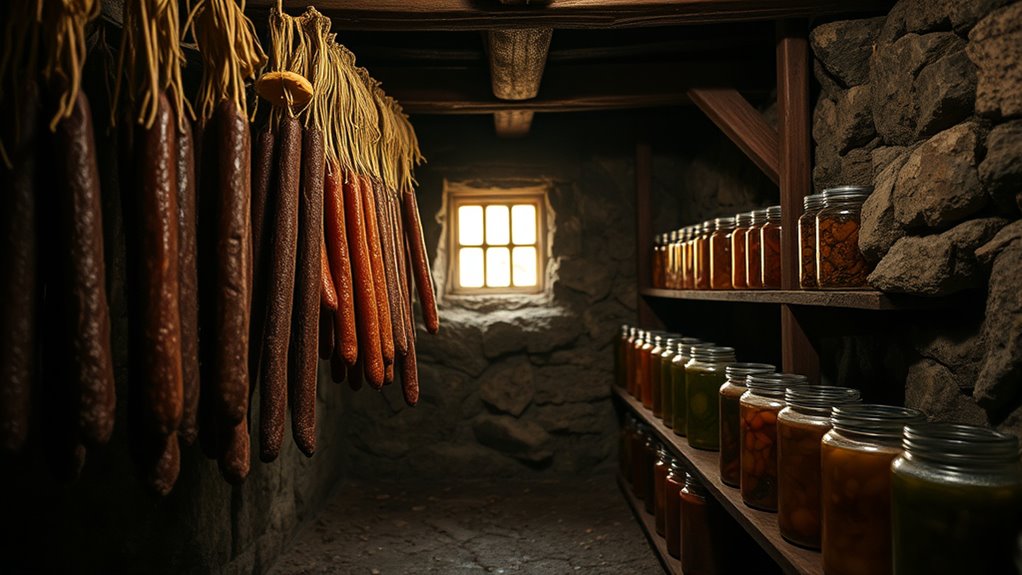To preserve meat without refrigeration, you can use techniques like salting, smoking, and drying. Salt draws out moisture and inhibits bacteria, while smoking adds flavor and extends shelf life. You can also create jerky by drying lean cuts of meat. For longer-term storage, consider seasonal freezing or pressure canning. Each method enhances flavor and longevity. Want to discover more about these preservation techniques and how to apply them effectively?
Key Takeaways
- Salting: Apply a salt concentration of 20-25% to draw out moisture and inhibit bacterial growth, enhancing meat flavor and longevity.
- Smoking: Use wood smoke to dry the surface of the meat, adding flavor and preventing moisture that leads to spoilage.
- Drying: Slice lean meats into thin strips and remove moisture through air drying, dehydrating, or using a low-heat oven for jerky.
- Vinegar Brining: Soak meat in vinegar brine to utilize acidity for flavor enhancement and bacterial inhibition, prolonging shelf life.
- Pressure Canning: Seal meat in jars and heat under pressure to kill harmful bacteria, allowing for safe, long-term storage without refrigeration.
Understanding Traditional Preservation Techniques

When it comes to preserving meat, understanding traditional techniques can make all the difference in flavor and shelf life.
These methods, like salting, draw out moisture from the meat to inhibit bacterial growth, enhancing taste and longevity.
Salting effectively removes moisture from meat, preventing bacterial growth while boosting flavor and extending its shelf life.
Smoking is another popular approach; it not only adds a unique flavor but also creates a hostile environment for bacteria through heat and smoke, greatly extending shelf life.
Sugar curing blends sugar and salt, perfect for hams and bacon, ensuring safety for long-term storage while delivering a sweet-savory taste.
Vinegar brining uses acidity to enhance flavor and also inhibits bacterial growth, while drying meat transforms seasoned strips into jerky, allowing you to store it without refrigeration for extended periods.
The Role of Salt in Meat Preservation

When you think about preserving meat, salt plays an essential role in the process.
It draws out moisture, which helps inhibit bacterial growth while enhancing the meat's flavor.
Understanding how to use salt effectively can make a significant difference in both preservation and taste.
Salt's Moisture Extraction Process
As you explore meat preservation, understanding salt's moisture extraction process is vital.
Salt acts as a primary preservative by drawing moisture out of meat through osmosis. When you cover the meat with salt, it causes the proteins to denature, releasing moisture that the salt then absorbs.
This process reduces water activity, making it harder for bacteria to thrive and extending the meat's shelf life. For effective preservation, aim for a salt concentration of 20-25%.
Proper application and storage are key; keep the salted meat in a cool, dry place to maximize its longevity.
Flavor Enhancement Through Salt
While salt is well-known for its preservation abilities, it also plays an essential role in enhancing the flavor of meat. When you first use salt to cure your meat, you'll notice how it draws out moisture, creating a savory, rich taste that's hard to resist.
Make sure you use the right concentration—about 1 pound of salt per 5 pounds of meat—for best results. This balance not only preserves your meat but also elevates its flavor without the need for chemical additives.
Combining salt curing with methods like smoking or sugar curing can deepen those flavors, resulting in complex profiles. With proper techniques, you can enjoy delicious, flavorful meat that lasts for months or even years.
Bacterial Growth Inhibition Techniques
Understanding how salt inhibits bacterial growth is essential for effective meat preservation. Salt acts as your ally in the quest to keep meat safe by drawing moisture out, creating an inhospitable environment for bacteria.
Most harmful bacteria need water to thrive, and with a concentration of around 20-25% salt, you can considerably reduce their chances of survival. Not only does salt preserve meat, but it also enhances its flavor.
You can further improve the curing process by adding sugar, which balances sweetness and aids moisture retention. Properly salted and cured meats can last for months or even years when stored correctly, showcasing salt's effectiveness as a preservation agent.
Embrace this technique for long-lasting, flavorful results!
Smoking: Flavor and Longevity

Smoking meat not only enhances its flavor but also considerably extends its shelf life by creating an environment that bacteria can't thrive in. By exposing meat to wood smoke for hours, you dry the surface and inhibit moisture, which is vital for bacterial growth. Depending on the type of wood you use, such as hickory or applewood, you can create unique flavor profiles while preserving your meat effectively. Properly smoked meats can last several months or even years if stored correctly.
| Wood Type | Flavor Profile |
|---|---|
| Hickory | Strong, bold, smoky |
| Applewood | Sweet, mild, fruity |
| Mesquite | Earthy, intense |
| Cherrywood | Sweet, rich, vibrant |
| Oak | Robust, balanced |
Sugar Curing for Enhanced Taste

Sugar curing not only enhances the flavor of meat but also serves as an effective preservation method. By combining sugar and salt, you create a sweet-savory profile that's perfect for hams and bacon.
The process involves rubbing a mixture of sugar and salt onto the meat, which draws out moisture and inhibits bacterial growth. This guarantees your meat remains safe and lasts for months or even years under the right conditions.
You can also customize your sugar curing with various spices and herbs, adding even more flavor. Just remember, the balance of sugar and salt is vital—too much sugar can make the meat overly sweet, while too little might compromise its preservation.
Enjoy experimenting with this versatile technique!
Vinegar Brining: A Flavorful Approach

If you're looking for a flavorful way to preserve meat, vinegar brining might be the perfect solution. This method involves submerging your meat in a mixture of vinegar, water, and spices, using the acidity to curb spoilage while enhancing flavor.
Not only does it keep your meat fresh for weeks or even months, but it also infuses it with a delicious tang.
This method not only preserves your meat for weeks or months but also adds a delightful tangy flavor.
Here's how you can get started with vinegar brining:
- Choose your meat: Pork and chicken work great for this method.
- Prepare the brine: Mix equal parts vinegar and water, adding your favorite spices.
- Submerge and store: Place the meat in the brine, ensuring it's fully submerged, and store it in a cool, dark place.
Utilizing Root Cellars for Storage

After exploring the vibrant flavors of vinegar brining, consider another age-old method for preserving meat: utilizing root cellars.
These cool, stable environments maintain temperatures between 32°F and 40°F, slowing spoilage. The earth's natural insulation helps regulate this ideal climate, allowing you to store meat without electricity.
Proper ventilation is essential; it prevents moisture buildup and mold, keeping your meats safe and flavorful.
In winter, you can optimize preservation by leveraging outdoor freezing temperatures.
To further enhance the longevity and taste of your stored meats, consider traditional techniques like salting or smoking.
Together, these methods work harmoniously in the cool conditions of a root cellar, ensuring your meats remain fresh and delicious for months.
Drying Meat: The Making of Jerky

When you're ready to make jerky, choosing quality cuts of meat is key to a tasty result.
Next, you'll want to focus on seasoning and marinating your strips to enhance flavor.
Finally, understanding the different drying techniques will help you achieve the perfect texture for your jerky.
Selecting Quality Cuts
Selecting quality cuts for making jerky is essential to achieving a delicious and long-lasting product. To guarantee your jerky turns out great, keep these tips in mind:
- Choose Lean Meats: Opt for cuts like beef round or flank steak. Higher fat content can spoil your jerky.
- Inspect for Freshness: Look for bright red meat with no off-odors. Freshness indicates peak quality for preservation.
- Trim and Slice Properly: Remove any visible fat and silverskin before slicing. Cut the meat against the grain into 1/4 inch thick strips for quicker drying and tenderness.
Seasoning and Marinating Tips
How can you elevate the flavor of your jerky while also helping to preserve it? Start by slicing lean cuts of meat into thin strips, about 1/8 to 1/4 inch thick.
Marinate those strips in a mixture of salt, spices, and optionally sugar or vinegar for at least 4-12 hours. This not only boosts flavor but draws out moisture, aiding preservation. Use spices like black pepper, garlic powder, or cayenne pepper for extra zest, as they also help inhibit bacterial growth. Additionally, ensuring your workspace and tools are clean can prevent contamination, similar to crop rotation practices that prevent pest buildup in farming.
After marinating, dry your meat in a dehydrator, low-heat oven, or air-dry in a ventilated area, ensuring an internal temperature of at least 160°F.
Store your jerky in airtight containers or vacuum-sealed bags to keep it fresh for months.
Drying Techniques Explained
Drying meat is a fundamental technique for preserving it, as it effectively removes moisture and creates an environment where bacteria can't thrive.
You can turn your meat into jerky by following these simple steps:
- Slice the Meat: Cut your chosen meat into thin strips for even drying.
- Season: Rub your strips with salt and spices to enhance flavor and prevent spoilage.
- Dry: Use air drying, a dehydrator, or a low-heat oven to remove moisture completely.
For added flavor and preservation, consider smoking the meat first.
This traditional method not only enhances taste but also helps create a hostile environment for bacteria.
Properly dried jerky can last for months or even years when stored correctly.
Seasonal Freezing Methods

When winter temperatures plunge, you can take advantage of seasonal freezing methods to preserve meat effectively. This technique allows you to store meats outdoors, freezing them solid and extending their shelf life without electricity.
To get started, make sure the meat is well-wrapped in airtight packaging to prevent moisture exposure and freezer burn. Ideally, outdoor temperatures should stay consistently below 32°F (0°C) to keep the meat frozen.
Keep an eye on the weather, as temperature fluctuations can affect your preservation efforts. Seasonal freezing is especially useful for large cuts of meat or game, letting you preserve bulk amounts efficiently.
With the right precautions, you can enjoy your preserved meat long after the winter months.
Pressure Canning for Long-Term Preservation

If you're looking for a reliable way to preserve meat for the long haul, pressure canning is an excellent option. This method seals meat in jars and heats them under pressure, effectively killing harmful bacteria and creating a vacuum seal.
When done properly, canned meats can last 3 to 5 years without refrigeration. Here are three key steps to get started:
- Obtain a Pressure Canner: Make certain you have a pressure canner that reaches high temperatures necessary for low-acid foods.
- Follow Tested Recipes: Use guidelines from reliable sources like the USDA to make certain safety and prevent foodborne illnesses.
- Store Properly: Keep your canned meats in a cool, dark place to maintain flavor and nutritional value.
Enjoy your sustainable food source!
Frequently Asked Questions
How Do Amish Preserve Meat Without Refrigeration?
The Amish use several methods to preserve meat without refrigeration. You'll find them salting the meat to draw out moisture, which prevents bacterial growth.
Smoking adds flavor while creating an inhospitable environment for bacteria. They also combine salt and sugar for curing, especially in hams and bacon.
Vinegar brining adds acidity, enhancing flavor and preventing spoilage.
Traditional techniques like drying and using root cellars showcase their resourcefulness and ability to maintain food freshness.
How Did People Preserve Meat Without Refrigeration?
Imagine living in a world where fresh meat's a fleeting dream!
People got creative, turning to salt to suck out moisture, keeping bacteria at bay. They smoked meat, infusing it with flavor while crafting an inhospitable environment for harmful microbes.
Sugar curing added sweetness, while drying transformed meat into jerky, perfect for long storage.
Vinegar brining introduced acidity, battling spoilage.
These ingenious methods showcased their resourcefulness, ensuring meat lasted long after the hunt was done.
How Long Can Meat Be Kept Without Refrigeration?
You can keep fresh meat at room temperature for about 1 to 2 hours before it becomes unsafe.
Cured meats, like those that are salted or smoked, can last weeks or even months.
Dried meats, such as jerky, can be stored safely for 1 to 2 years in a cool, dry place.
If you pressure can meat, it can last 3 to 5 years without refrigeration, thanks to the airtight seal and cooking process.
How Do You Preserve Meat in a Survival Situation?
In a pinch, you'll want to give your meat a fighting chance. Start by smoking it, letting the heat and smoke work their magic against pesky bacteria.
You can also sprinkle some salt to draw out moisture, creating a flavorful barrier. If you've got the time, try drying it into jerky or using vinegar brining for a zesty twist.
And don't forget about a root cellar for that cool, dark sanctuary!
Conclusion
Preserving meat without refrigeration is an art that combines tradition and technique. By exploring methods like salting, smoking, and drying, you can guarantee your meat lasts longer while enhancing its flavor. Remember, "an ounce of prevention is worth a pound of cure." With the right practices, you can enjoy delicious, preserved meats that stand the test of time. So, embrace these age-old techniques, and you'll never have to worry about spoilage again!









